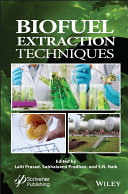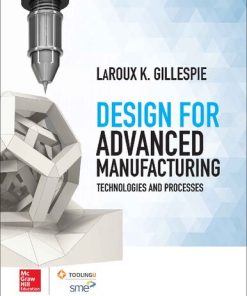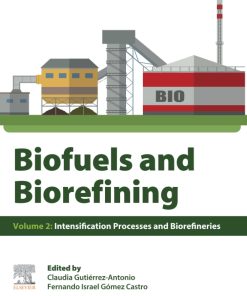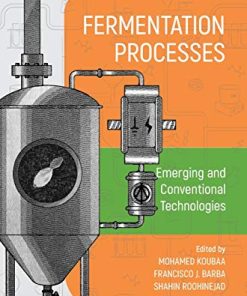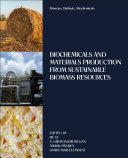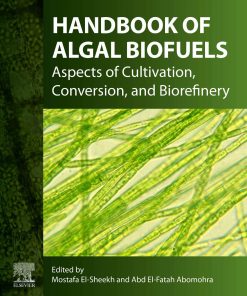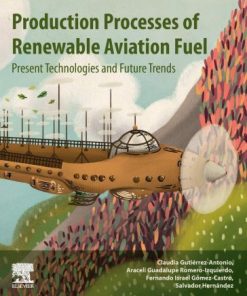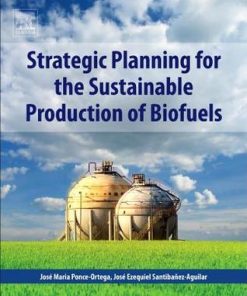Handbook of Biofuels Production Processes and Technologies 1st edition by Rafael Luque, Carol Lin, Karen Wilson, Chenyu Du 0323915212 9780323915212
$50.00 Original price was: $50.00.$25.00Current price is: $25.00.
Handbook of Biofuels Production: Processes and Technologies 1st edition by Rafael Luque, Carol Lin, Karen Wilson, Chenyu Du – Ebook PDF Instant Download/DeliveryISBN: 0323915212, 9780323915212
Full download Handbook of Biofuels Production: Processes and Technologies 1st edition after payment.
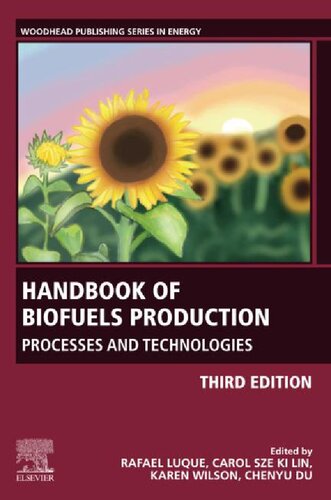
Product details:
ISBN-10 : 0323915212
ISBN-13 : 9780323915212
Author: Rafael Luque, Carol Lin, Karen Wilson, Chenyu Du
Handbook of Biofuels Production: Processes and Technologies, Third Edition provides a comprehensive and systematic reference on a range of biomass conversion processes and technologies. In response to the global increase in the use of biofuels as substitute transportation fuels, advanced chemical, biochemical and thermochemical biofuels production routes are quickly being developed. Substantial additions for this new edition include increased coverage of emerging feedstocks, including microalgae, more emphasis on by-product valorization for biofuels’ production, additional chapters on emerging biofuel production methods, and co-production of biofuels and bioproducts.
Handbook of Biofuels Production: Processes and Technologies 1st Table of contents:
Part One: Key issues and assessment of biofuels production
Chapter 1: Introduction: An overview of biofuels and production technologies
Abstract
1.1: Introduction
1.2: Biofuel production processes and technologies
1.3: Technoeconomic and environmental assessment
1.4: Challenges, opportunities, and future prospects in biofuel production
1.5: Conclusion
References
Chapter 2: Life cycle assessment of biofuels
Abstract
2.1: Main challenges to biofuel sustainability
2.2: LCA methodology
2.3: Biomass to biofuel conversion routes
2.4: Overview of major findings of selected LCA studies on biofuel production
2.5: Conclusions
References
Further reading
Chapter 3: Biofuels: Technology, economics, and policy issues
Abstract
3.1: Introduction
3.2: Moving from fossil fuel to biofuels: Insights from sociotechnical transition theory
3.3: Assessment of first- and next-generation biofuels
3.4: Economic, environmental, and social issues
3.5: Policy actions and regulatory frameworks
3.6: Conclusions
References
Further reading
Chapter 4: Feedstocks and challenges to biofuel development
Abstract
Disclaimer
4.1: Introduction
4.2: First-generation (1G) feedstocks
4.3: Second-generation (2G) feedstocks
4.4: Third-generation (3G) feedstocks
4.5: Conclusions and future outlook
References
Part Two: Biofuels from chemical and biochemical conversion processes and technologies
Chapter 5: Production of biofuel via catalytic upgrading and refining of sustainable oleaginous feedstocks
Abstract
Acknowledgments
5.1: Introduction: Renewable diesel
5.2: Overview of biodiesel production and feedstock
5.3: Catalytic biodiesel production
5.4: Production of green diesel
5.5: Concluding remarks
References
Chapter 6: Biotechnological production of biofuels
Abstract
Acknowledgments
6.1: Introduction
6.2: Lipases
6.3: Enzymatic production of biodiesel
6.4: New tendencies in the enzymatic production of biodiesel
6.5: Biofuels similar to biodiesel produced using acyl acceptors other than methanol
6.6: Industrial biodiesel production using enzymes
6.7: Conclusions
References
Chapter 7: Biodiesel production from microbial lipids using oleaginous yeasts
Abstract
7.1: Introduction
7.2: Oleaginous yeasts
7.3: SCO metabolism in oleaginous yeasts
7.4: Oleaginous microorganism engineering
7.5: Feedstock for SCO production
7.6: SCO production techniques
7.7: High-value-added polyunsaturated fatty acids
7.8: Conclusions and future prospects
References
Chapter 8: Biochemical production of bioalcohols
Abstract
Acknowledgments
8.1: Introduction
8.2: Types of bioalcohols
8.3: Bioalcohol production from lignocellulose hydrolysate
8.4: Bioalcohol production from lignocellulose via CBP using single microbes
8.5: Bioalcohol production from lignocellulose via CBP through co-cultivation
References
Chapter 9: Production of biogas via anaerobic digestion
Abstract
9.1: Introduction
9.2: Factors affecting the AD process
9.3: Feedstocks used for biogas and fertilizer production
9.4: Anaerobic bioreactor technology
9.5: Anaerobic digestion modeling
9.6: Biological biogas upgrade
9.7: Integration of biogas plants in the circular economy concept
9.8: Conclusions and future trends
References
Chapter 10: Lignocellulose biorefinery advances the liquid biofuel platform
Abstract
10.1: Introduction
10.2: A low-carbon future
10.3: Advanced liquid biofuel platform
10.4: Conclusion
References
Chapter 11: Chemical routes for the conversion of cellulosic platform molecules into high-energy-density biofuels
Abstract
Acknowledgments
11.1: Introduction
11.2: Oxygenated fuels via 5-HMF: Furanic compounds
11.3: Levulinic acid as a platform molecule for oxygenated fuels: Alkyl levulinates and valeric biofuels
11.4: Oxygenated fuels via furfural: Furan derivatives
11.5: Blending of oxygenated biofuels with conventional fuels
11.6: Furan derivatives as platform molecules for liquid hydrocarbon fuels
11.7: Catalytic conversion of LA and its derivatives into fuel-range hydrocarbons
11.8: Final remarks and future outlook
References
Part Three: Biofuels from thermal and thermo-chemical conversion processes and technologies
Chapter 12: The catalytic processes for the deoxygenation and densification of biofuels
Abstract
12.1: Introduction
12.2: Catalytic approaches for deoxygenation of bio-crude
12.3: C–C coupling strategies for bio-crude densification
12.4: Hydrotreatment of bio-crude
12.5: Type of reactors for embedding catalysts for near complete deoxygenation
References
Chapter 13: Production of bio-syngas and bio-hydrogen by gasification
Abstract
13.1: Introduction
13.2: The gasification process
13.3: Feedstocks
13.4: Syngas production
13.5: H2 production
13.6: Products and product quality
13.7: The future
References
Chapter 14: Production of biofuels via Fischer-Tropsch synthesis: Biomass-to-liquids
Abstract
14.1: Introduction
14.2: Biomass-to-liquid process steps and technologies
14.3: Biomass-to-liquid final fuel products
14.4: Environmental and economic considerations of the BTL process
14.5: Commercial status of the biomass-to-liquid processes
14.6: Future prospects and challenges
References
Part Four: Integrated production and application of biofuels
Chapter 15: Integrated biorefineries for the co-production of biofuels and high-value products
Abstract
Acknowledgments
15.1: Introduction
15.2: Integrated production of biofuels and high-value products
15.3: Case studies
15.4: Conclusion and future work
References
Chapter 16: Microalgae for biofuels: A prospective feedstock
Abstract
Acknowledgments
16.1: Introduction
16.2: Scaling-up of microalgae cultivation system
16.3: Photoautotrophic, heterotrophic and mixotrophic cultivation of microalgae
16.4: Limiting factors for mass microalgae cultivation
16.5: Microalgal lipids
16.6: Microalgal lipid biosynthesis
16.7: Microalgal biomass harvesting
16.8: Microalgae dewatering
16.9: Microalgal oil extraction and transesterification
16.10: Conclusions and future perspectives
People also search for Handbook of Biofuels Production: Processes and Technologies 1st:
handbook of biofuels production pdf
handbook of biofuels production processes and technologies pdf
handbook of biofuels production processes and technologies
handbook of biofuels production (second edition)
handbook of biofuels pdf
Tags: Handbook, Biofuels Production, Processes, Technologies, Rafael Luque, Carol Lin, Karen Wilson, Chenyu Du
You may also like…
Engineering
Technique - Fuel Technology
Biology and other natural sciences - Ecology
Biology and other natural sciences - Biotechnology
Handbook of Algal Biofuels: Aspects of Cultivation, Conversion, and Biorefinery 1st Edition
Engineering
Strategic Planning for the Sustainable Production of Biofuels Jose Ezequiel Santibanez-Aguilar




